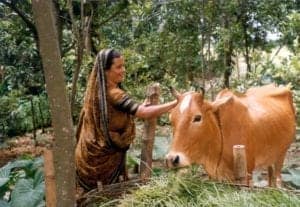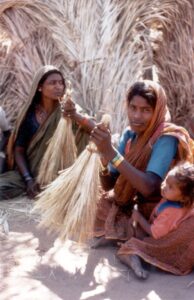As digital and mobile tools become more and more accessible to even the most remote and developing markets, we often hear about the “promise” of digital financial services to provide a solution for unbanked women. What does it mean to truly deliver on this promise?
Just adding a digital or mobile component to an account or service does not mean it will reach clients, especially women. In the same way, offering access to limited services like payments or transfers does not translate to meaningful financial inclusion for women. As a result, many digital financial service providers are missing the mark when delivering on the promise.
A History of Financial Inclusion
With support from MetLife Foundation, Women’s World Banking had the opportunity to investigate how this is playing out in one of the most fascinating markets for financial inclusion: Bangladesh.

We examined how bank-led mobile financial services or MFS (the term used for mobile phone digital products in Bangladesh) are rapidly expanding in the market with a focus on the implications for women’s financial inclusion. The opportunity is undeniable: MFS already surpassed non-bank providers such as microfinance institutions and is positioned to surpass traditional banks as well. However, these services as currently configured are failing to meet the requirements for true financial inclusion.
Untapped Potential
Assisted channels, such as agents conducting over-the-counter (OTC) money transfer or payment transactions via mobile technology, dominate the market in Bangladesh. OTC transactions can be seen as a stepping stone towards financial inclusion for populations with low levels of literacy, less technological knowledge and low barriers to entry (e.g. not requiring formal registration and its attendant forms and requirements). The appeal shows in the numbers: 13 percent of adults in Bangladesh have an MFS account while 28 percent use MFS without an account (unregistered).
However, there are drawbacks to the un-registered OTC model. Transactions are low—five per month for OTC users versus 11 for registered users. Bank of Bangladesh is also concerned that agents could take advantage of low-income users (higher transaction fees, risk of fraud and theft).
Additionally, unregistered users miss out on the benefits of having a formal bank account, including access to savings and other banking services.
While MFS user numbers are growing, the gender gap is significant. Only 27 percent of women use MFS versus 53 percent of men, and only 6 percent of women have a registered account versus 19 percent of men. MFS has the opportunity to demonstrate to the larger financial sector the potential and power of the profitable and sustainable low-income women’s market.
Understanding Barriers Facing Women
 While OTC transactions through agents are simple, registering and using formal accounts can be intimidating for women who face a number of barriers. Financial service providers often fail to understand these barriers and assume it’s just a matter of time before women pick up new digital products.
While OTC transactions through agents are simple, registering and using formal accounts can be intimidating for women who face a number of barriers. Financial service providers often fail to understand these barriers and assume it’s just a matter of time before women pick up new digital products.
We conducted focus groups with both MFS providers and women OTC users in Bangladesh and noticed a strong disconnect between how the two groups perceived usability of accounts. When asked about the mobile account interface, the providers reported that “English is not an issue” for women, and “I’m amazed at how well they adapt.” However, the women cited significant language and comprehension barriers. One participant said: “The English writing we cannot read, if they can make it in Bangla, we can understand.” Another said: “If it [used] emoticons, I could understand at least if they received the money with a happy face.”
Social barriers are a hurdle as well. While MFS providers believe women are comfortable with male agents, we heard a different perspective. One woman explained: “At the store, the agent is always male, but if it were a woman, I would prefer it because sometimes the boys will try to talk to me and ask a lot of leading questions to find out if I’m married.” This disconnect reveals a lot of room for improvement in serving women successfully.
Meeting Women’s Unique Financial Needs
Decades of research by Women’s World Banking shows that women have very complicated financial lives, and this definitely holds true in Bangladesh. In the household, women take charge of saving for emergencies, meeting health expenses, paying school fees and planning for the future. While OTC transactions meet short term transfer and payment needs they do not meet women’s and the family’s varied and complex financial needs.
Let’s look at the top three types of transactions by OTC users and examples of how a female user may conduct these transactions:
1. Cash-In Transactions (41%). She gives cash to the agent in order to transfer money to school for her children’s education fees.
2. Utility Payments (39%). She pays the family’s water and electricity bills.
3. Person-to-Person Transactions (15%). She transfers money to her parents in a neighboring village.
If these are her typical transactions, what’s missing? Where is the savings for her future? The loan for her business? The insurance in case of emergency? According to our research on savings mechanisms in Bangladesh, most low-income women are using informal, insecure means like samitis (traditional savings collectors) or stashing their emergency funds at home. If MFS providers designed savings accounts to better meet women’s needs, women will be more likely to use these accounts frequently and also access other banking products—a win-win for the client and the institution.
Delivering on the Promise
Based on their current reach in the market and success with transactional services, MFS providers in Bangladesh hold enormous potential to engage low-income women as active banking customers. With a deeper understanding of women’s lives and financial behaviors, here are our recommendations for reaching this potential:
1. Develop marketing and sales approaches that focus on women’s needs to onboard more active women clients. Materials and messages should be tailored to women clients and supplemented by one-on-one interactions with women agents and sales representatives.
2. Offer simplified interfaces through multiple channels that overcome barriers facing women. By improving product usability and testing additional digital channels (e.g. ATMs and mobile applications), providers can increase usage among women clients.
3. Make additional banking services available that meet women’s complex financial needs. Improve loyalty and transaction frequency among women clients by offering products and services like long-term savings and loan payment that are convenient and will help her build financial security.
With a rich history of pioneering financial inclusion efforts for women, Bangladesh is poised to make great strides in closing the gender gap. By researching women clients to truly understand their unique needs and designing products to meet those needs, MFS providers can deliver on the promise the technology can achieve for unbanked women.



